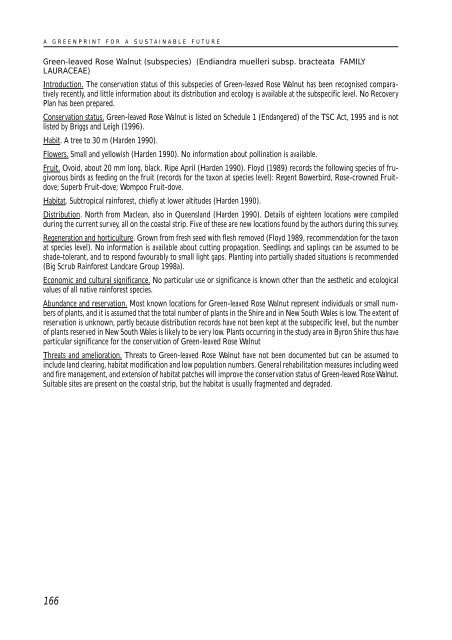Byron Flora and Fauna Study 1999 - Byron Shire Council
Byron Flora and Fauna Study 1999 - Byron Shire Council
Byron Flora and Fauna Study 1999 - Byron Shire Council
You also want an ePaper? Increase the reach of your titles
YUMPU automatically turns print PDFs into web optimized ePapers that Google loves.
A GREENPRINT FOR A SUSTAINABLE FUTURE<br />
Green-leaved Rose Walnut (subspecies) (Endi<strong>and</strong>ra muelleri subsp. bracteata FAMILY<br />
LAURACEAE)<br />
Introduction. The conservation status of this subspecies of Green-leaved Rose Walnut has been recognised comparatively<br />
recently, <strong>and</strong> little information about its distribution <strong>and</strong> ecology is available at the subspecific level. No Recovery<br />
Plan has been prepared.<br />
Conservation status. Green-leaved Rose Walnut is listed on Schedule 1 (Endangered) of the TSC Act, 1995 <strong>and</strong> is not<br />
listed by Briggs <strong>and</strong> Leigh (1996).<br />
Habit. A tree to 30 m (Harden 1990).<br />
Flowers. Small <strong>and</strong> yellowish (Harden 1990). No information about pollination is available.<br />
Fruit. Ovoid, about 20 mm long, black. Ripe April (Harden 1990). Floyd (1989) records the following species of frugivorous<br />
birds as feeding on the fruit (records for the taxon at species level): Regent Bowerbird, Rose-crowned Fruitdove;<br />
Superb Fruit-dove; Wompoo Fruit-dove.<br />
Habitat. Subtropical rainforest, chiefly at lower altitudes (Harden 1990).<br />
Distribution. North from Maclean, also in Queensl<strong>and</strong> (Harden 1990). Details of eighteen locations were compiled<br />
during the current survey, all on the coastal strip. Five of these are new locations found by the authors during this survey.<br />
Regeneration <strong>and</strong> horticulture. Grown from fresh seed with flesh removed (Floyd 1989, recommendation for the taxon<br />
at species level). No information is available about cutting propagation. Seedlings <strong>and</strong> saplings can be assumed to be<br />
shade-tolerant, <strong>and</strong> to respond favourably to small light gaps. Planting into partially shaded situations is recommended<br />
(Big Scrub Rainforest L<strong>and</strong>care Group 1998a).<br />
Economic <strong>and</strong> cultural significance. No particular use or significance is known other than the aesthetic <strong>and</strong> ecological<br />
values of all native rainforest species.<br />
Abundance <strong>and</strong> reservation. Most known locations for Green-leaved Rose Walnut represent individuals or small numbers<br />
of plants, <strong>and</strong> it is assumed that the total number of plants in the <strong>Shire</strong> <strong>and</strong> in New South Wales is low. The extent of<br />
reservation is unknown, partly because distribution records have not been kept at the subspecific level, but the number<br />
of plants reserved in New South Wales is likely to be very low. Plants occurring in the study area in <strong>Byron</strong> <strong>Shire</strong> thus have<br />
particular significance for the conservation of Green-leaved Rose Walnut<br />
Threats <strong>and</strong> amelioration. Threats to Green-leaved Rose Walnut have not been documented but can be assumed to<br />
include l<strong>and</strong> clearing, habitat modification <strong>and</strong> low population numbers. General rehabilitation measures including weed<br />
<strong>and</strong> fire management, <strong>and</strong> extension of habitat patches will improve the conservation status of Green-leaved Rose Walnut.<br />
Suitable sites are present on the coastal strip, but the habitat is usually fragmented <strong>and</strong> degraded.<br />
166

















